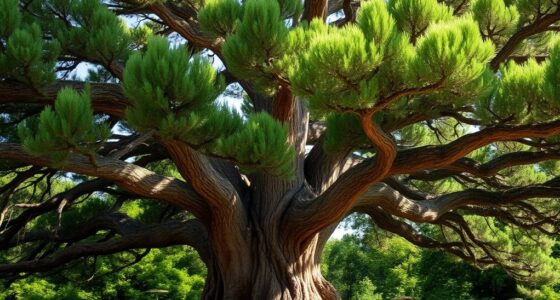Many of Africa’s oldest baobab trees, crucial for ecosystems and cultural heritage, are dying due to climate change. Rising temperatures, prolonged droughts, and irregular rainfall weaken these iconic giants, threatening their survival. Efforts to protect and restore them are underway, but challenges remain. If you want to understand how climate impacts these endangered giants and what’s being done to save them, there’s more to discover that could inspire action.
Key Takeaways
- Africa’s oldest baobab trees are experiencing decline due to rising temperatures and prolonged droughts caused by climate change.
- These ancient trees are vital ecosystems and cultural symbols, now at risk of extinction.
- Conservation efforts include habitat protection, monitoring technology, and propagation to preserve remaining specimens.
- Climate change outpaces current conservation resources, threatening the survival of these endangered giants.
- Urgent global and local actions are needed to combat climate impacts and protect Africa’s iconic baobabs.

Baobab trees, often called the “Tree of Life,” are facing increasing threats that put their survival at risk. These majestic giants are not just iconic symbols of Africa’s landscape; they’re essential ecosystems that support countless species and local communities. Yet, climate change impacts are accelerating their decline. Rising temperatures, prolonged droughts, and unpredictable rainfall patterns weaken these ancient trees, making it harder for them to thrive. As the climate shifts, water scarcity becomes a serious issue, stressing the baobabs’ ability to survive and reproduce. This ongoing climate crisis threatens to wipe out some of the oldest and most iconic specimens, risking the loss of invaluable genetic and cultural heritage.
You might wonder what’s being done to save these giants. Conservation efforts are stepping up, with local communities, scientists, and governments joining forces. Many projects focus on protecting existing baobab populations, establishing protected areas, and restoring damaged habitats. Some initiatives involve monitoring the health of trees through drone technology and satellite imagery, allowing experts to identify at-risk trees before it’s too late. In addition, seed banks and nurseries are working to propagate baobabs, ensuring that future generations can still enjoy these ancient trees. Education campaigns are also indispensable, raising awareness about the importance of conserving these trees and how climate change exacerbates their decline. Promoting climate resilience is crucial for ensuring the long-term survival of these trees in a changing environment.
Despite these efforts, challenges remain. The scale of climate change impacts often outpaces conservation actions, especially in regions where resources are limited. You can help by supporting organizations dedicated to protecting baobabs and advocating for policies that address climate change. Every action counts, from reducing your carbon footprint to spreading awareness about the importance of preserving these natural wonders. The fight to save the baobabs isn’t just about saving trees; it’s about safeguarding a critical part of Africa’s natural and cultural history. As these trees continue to face mounting threats, your involvement can make a difference in ensuring that future generations can still stand beneath the shade of these ancient giants. The clock is ticking, but through concerted conservation efforts and climate action, there’s still hope to preserve the life and legacy of Africa’s most iconic trees.
Frequently Asked Questions
How Long Do Baobab Trees Typically Live?
You’ll find that ancient giants like baobab trees typically live between 1,000 to 2,000 years, showcasing remarkable tree longevity. These majestic trees often stand as symbols of resilience and history in their environments. Their impressive age allows them to become integral parts of local ecosystems and cultures. However, with threats like climate change, some of these ancient giants are now at risk of dying earlier than their natural lifespan.
Are Baobab Trees Protected by Law?
You’d think these ancient giants get VIP treatment, but surprisingly, baobab trees aren’t universally protected by law. Some countries have legal protections and conservation efforts, trying to save them from threats like deforestation and climate change. However, enforcement varies, and many ancient baobabs still face danger. So, while laws exist, you might wonder if they’re enough to keep these legendary trees alive for future generations.
What Are the Main Causes of Baobab Tree Decline?
You should know that climate change and deforestation are the main causes of baobab tree decline. Rising temperatures and changing rainfall patterns stress these ancient trees, making it harder for them to survive. Deforestation reduces their habitat and damages root systems, accelerating their decline. If you want to help, support conservation efforts and fight climate change, because protecting these iconic trees depends on addressing these critical threats.
Can Dying Baobabs Be Preserved or Saved?
You can save dying baobabs through targeted conservation efforts and community involvement. For example, in Madagascar, local communities helped protect a dying ancient baobab by removing invasive species and monitoring health. Such actions slow decline and promote recovery. Engaging communities guarantees ongoing care and awareness, making preservation feasible. While some trees may not fully recover, these efforts improve their chances of survival and highlight the importance of collective responsibility.
How Do Baobab Trees Impact Local Ecosystems?
You help support the crucial role baobab trees play in ecosystems by understanding their impact. These trees provide shelter and food, aiding seed dispersal and supporting diverse species. As climate change threatens their survival, preserving baobabs maintains ecological stability, ensuring that animals and plants benefit from their presence. Protecting these giants helps sustain the intricate balance in their habitats, which is essential for overall ecosystem health.
Conclusion
Remember, a tree is known by its fruit. As Africa’s oldest baobabs die, it’s a stark reminder of how fragile our natural treasures are. You have the power to help protect these giants by spreading awareness and supporting conservation efforts. If we don’t act now, future generations may never see these majestic trees standing tall. Let’s not wait until it’s too late—because once a tree is gone, it’s gone forever.










